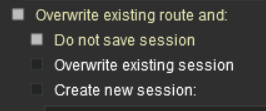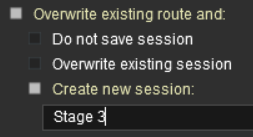How to Use the UDS Interface
The information in this Wiki Page applies to TRS19 Platinum Edition and Trainz Plus. Older versions of Trainz, including T:ANE and TRS19 (standard), do not have the UDS feature described in this document.
Contents |
What is the UDS Interface?
| The UDS provides a means of quickly switching from Driver mode to Surveyor mode and back to Driver again without having to restart a running session after each switch. It is only available in TRS19 Platinum Edition and Trainz Plus | |
| The UDS replaces the QuickDrive Rule in TRS19 Platinum Edition and Trainz Plus |
UDS stands for Unified Driver Surveyor and is an "interface' or option built into TRS19 Platinum Edition and Trainz Plus that allows you to jump seamlessly from Driver into Surveyor and then back into Driver again to resume a session at the point where you left it. There is no need to restart a Driver session from the very beginning.
| The Scenario: You are in Driver mode testing out a route and session when you discover a problem. |
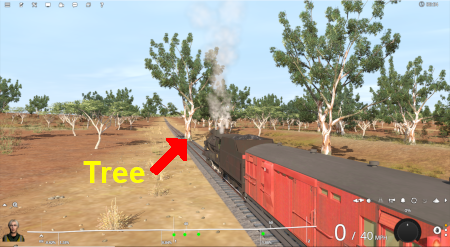 | Previously (before UDS) your only options would be to:-
In both cases you would have to:-
|
The UDS interface allows you to halt the Driver session (press the P key) and then switch, via a menu option, to Surveyor without having to stop and exit Driver mode first.
| The Scenario (continued): Using UDS you switch from Driver to Surveyor with the currently active Driver consist still as the focus and at the place it was located when you switched into Surveyor from Driver. |
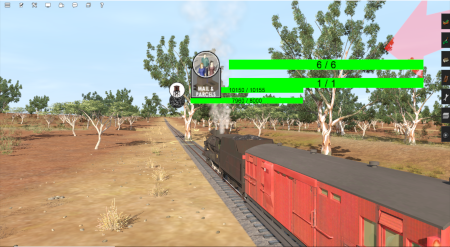 | All the Surveyor tools and options are available for you to use, including the Session Editor (more on that later). | |
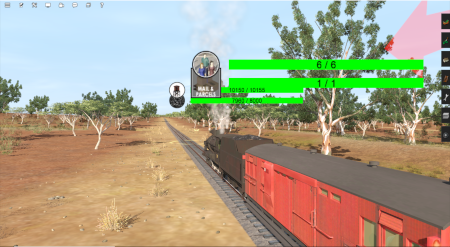 | You use the Surveyor tools to fix the problem, such as deleting (as shown left), moving or adding a scenery object. You can then (if you wish) save the edited route and/or session (again there will be more on that later). |
|
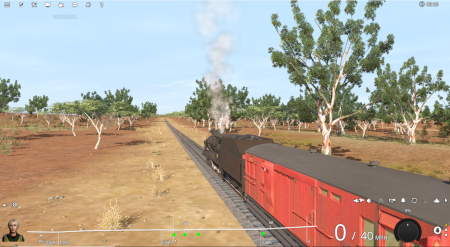 | You then switch back into Driver to continue driving the session with the problem fixed. |
Switching Modes
| When in Driver Mode Switching to Surveyor | ||||||
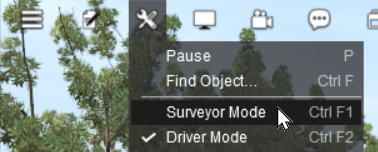 |
Open the Tools Menu and select Surveyor Mode
|
|||||
| When in Surveyor Mode Switching to Driver | ||||||
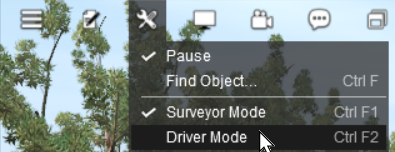 |
Open the Tools Menu and select Driver Mode
|
|||||
Saving
| Warning: | |
| If you decide to save your Surveyor edits and select the option to
|
|
Most of the problems users seem to be experiencing with the UDS, judging from the posts in the Trainz Forums, is when saving their edited Driver session after switching to Surveyor mode.
| Using Driver Mode involves driving consists (either manually or through the AI) and activating rules. These will change the session parameters | |
| Overwriting the Session will save the consist locations and Session Rules in their new positions/conditions |
| Notes: An important change that has been introduced by the UDS is that train vehicle placement is now saved as part of the Session, even if those vehicles have been placed in Route Layers. |
| In TRS19 Platinum Edition and in Trainz Plus it is recommended that all consists should be placed into a Session Layer and become part of a Session instead of the Route |
When you are in Driver Mode at least one of the consists will probably be moving. Some of the Session rules may have already been completed while others may still be running or waiting for events (e.g. triggers to be activated).
If you then choose to save using the Overwrite existing session option then you will be replacing your original starting Session with a new one with the consists saved in their new positions and the Session rules saved in their new states. So when you later load and restart the Session things will not be the same as they were in the original or starting Session.
Unless you have a particular reason for overwriting the original Session then the recommended save options are:-
| Do not save session
|
|
| Create new session
|
Resetting the Session Rules
| After you switch from Driver Mode to Surveyor Mode it may be necessary to restart or reset some of the Session Rules |
As mentioned above, when Driver Mode is running some of the Session rules may be completed while others may still be running or waiting for certain events (e.g. triggers to be activated). When you switch to Surveyor Mode these rules may be in a different state compared to what they were at the start of the Session. When you restart Driver Mode these rules may not be in a useful condition.
The Session Editor built into all Trainz versions allows you to add, delete and modify the rules that will operate during a Session. More information on the Session Editor can be found on the Trainz Wiki at Using the Session Editor
To open the Session Editor open the Edit menu and select Edit Session
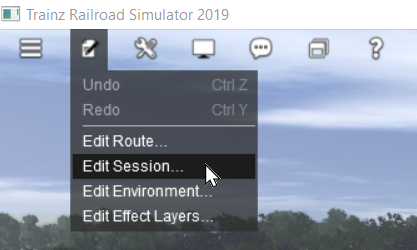

| At the bottom of the Session Editor is a new button, Reset All Rules. This will reset or restart ALL rules in the Session. |
|
 |
Some rules, as shown in the screen shot above, have the label (Complete was-complete) after the rule name. This indicates that the rule has already been completed. These rules can be individually restarted by right mouse clicking on the rule and selecting the Reset option from the pop up menu. This will change the rule status to (Paused). |
| When the Driver Mode is selected again, all the reset or Paused rules will be restarted. | |
Some Questions Answered
| I have only edited assets that are in the Route layers but selecting Save always sets the option to "Overwrite exiting session" as the default. Why? |
Many scenery assets actually have their properties stored in the Session, even when the assets themselves are in a Route layer. Editing the properties of these assets is considered to be a change to the Session. These include:-
- junction switches - the left/right switch direction is stored in the Session
- industries - the commodities and quantities loaded/unloaded are stored in the Session
- industry enabled wagons - the commodities and quantities carried are stored in the Session
- consist locations - this is stored in the Session (TRS19 Platinum Edition and Trainz Plus only)
- named route objects - while the name is stored in the Route, adding or changing the name is treated as a change to the Session
| Interlocking Towers (including Enhansed Interlocking Towers) show paths as "not editable" after switching to Surveyor Mode. Why? |
If you make the switch from Driver Mode to Surveyor Mode after an IT/EIT path has been activated (but not yet cleared or cancelled) then you will be unable to edit that path. In addition, you will not be able to add new paths to an IT/EIT that has an open active path.
Pierre (pguy), the creator of the EIT asset and associated rules, has a detailed description of this and some possible solutions in a Trainz Forum post at:- EITs and the UDS
| Does the UDS alter the operation of portals? |
A train that is driven into a portal and later returned to the layout will be returned in the same layer as the portal and not in the trains originally assigned layer. Trains that are produced by a portal will be assigned to the same layer as the portal. This has possibly always been the case with portals but was probably unnoticed until the arrival of the UDS. It seems to have no other noticeable effect on trains.
This could become an issue if you make the switch from Driver to Surveyor after a train has been returned to the layout from a portal and will no longer be in its originally assigned layer. For example, if a train is originally in a Session Layer then it is part of a Session. If it is returned from a portal just before switching from Driver to Surveyor and the Route is saved, then the train will be saved in the Route not the Session. If this is an issue then the remedy is to open the property dialogue window of any wagon in the train after it has left the portal and change its assigned layer to the correct one. This will set all vehicles in that train to the same correct layer.
Trainz Wiki
 |
More Tutorials and Guides to Using Trainz |
This page was created by Trainz user pware in June 2021 and was last updated as shown below.

